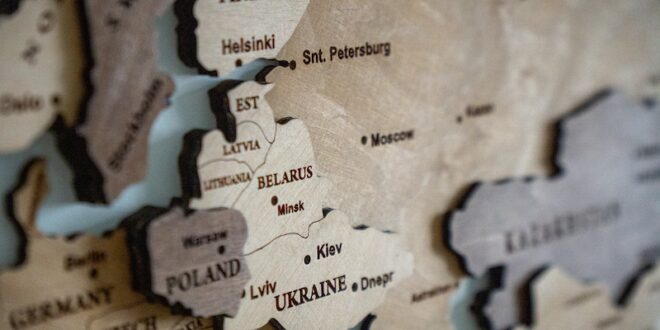Relations between Belarus and its NATO neighbours deteriorated further over the summer. Troops have been deployed on both sides of the Belarus–Poland border, and each country has accused the other of escalating tensions. Lithuania this month closed two of six border crossings with Belarus. Belarus’s defence minister, Viktor Khrenin, went as far as suggesting that ‘the possibility of a direct military clash with NATO in the future has become quite obvious’.
While Belarus is not officially a party to Russia’s war in Ukraine, it has allowed Russian forces to attack Ukraine from Belarusian soil. Furthermore, thousands of troops from the Wagner Group private military company reportedly moved to Belarus following their short-lived uprising against Moscow in June. And suspicions have been voiced in Ukraine that Russia hopes to drag Belarus into the war as its ally. But what of Belarus’s own military? What investment has it seen in recent years, and can it be considered a credible threat to its neighbours?
To give some insight into these questions, this topical backgrounder draws on SIPRI’s military expenditure and arms transfers databases. It assesses trends in Belarus’s military spending and then looks at what major arms the country has imported over the past two decades. This data is compared with Belarus’s northern and western neighbours Latvia, Lithuania and Poland—all of which were part of the Warsaw Treaty Organization during the cold war (Latvia and Lithuania, like Belarus, as part of the Soviet Union) but have since joined NATO. Finally, the backgrounder offers some analysis of what all this tells us about Belarus’s military capabilities.
Military expenditure
Based on official Belarusian government documents, Belarus’s military budget for 2022 was US$821 million—15 per cent more, in real terms, than in 2013. However, reported actual military spending in 2022 exceeded the budget by 35 per cent, reaching around $1.1 billion. While concerns about the war in Ukraine may have spurred some of this new spending, it could also be linked to high inflation in Belarus during the year.
The military burden—military spending as a proportion of GDP—is the simplest measure of the priority a country gives to the military sector. Even with the additional spending, Belarus’s military burden in 2022 was 1.6 per cent of GDP. This was well below the global average of 2.2 per cent and the European average of 2.5 per cent in the same year.
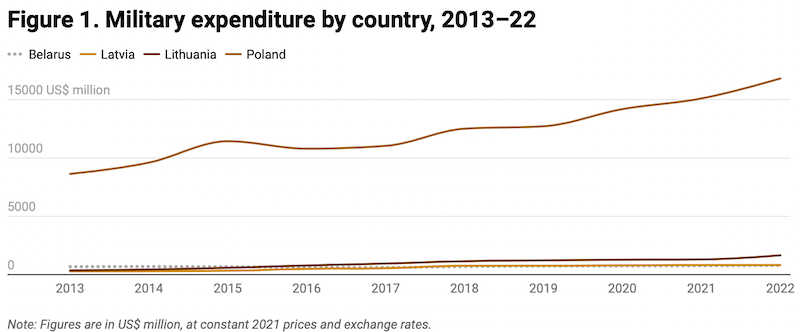
All three of Belarus’s NATO neighbours devoted significantly larger shares of their GDPs to military spending. In absolute terms, both Latvia and Lithuania have had roughly comparable military spending with Belarus since the end of the cold war. Latvia’s spending surpassed that of Belarus in 2018 (see figure 1). It reached $849 million in 2022, or 2.05 per cent of GDP. Lithuania’s military spending surpassed that of Belarus in 2016 and reached $1.7 billion in 2022, or 2.52 per cent of GDP. Poland’s military spending dwarfs that of Belarus. It reached $16.6 billion in 2022, or 2.39 per cent of GDP, and in January this year Prime Minister Mateusz Morawiecki announced a new military spending target of 4 per cent of GDP.
Imports of major arms
Belarus
The official Belarusian data indicates that procurement spending represented about 29 per cent of actual total military spending in 2022, up from 16 per cent in 2021. Despite this steep year-on-year increase, the share in 2022 was smaller than that reported by many NATO members. Belarus’s procurement spending for 2022 was about $309 million. This is far below Lithuania’s military procurement budget of about $600 million, and Poland’s of $5.9 billion.
While official data on military spending cannot be independently verified and may be somewhat unreliable, a review of Belarusian imports of major arms reinforces this impression of relatively low spending on military procurement. (Belarus relies almost entirely on imports for major arms.)
The military of Belarus continues to rely heavily on Soviet-era military equipment and, since declaring its independence from the Soviet Union in 1991, Belarus has remained almost entirely dependent on Russian imports for any new major arms procurements.
According to SIPRI data, the only major arms that Belarus imported between 1993 and 2002 were an estimated four MiG-29 combat aircraft from Russia in 1998. Between 2003 and 2012, Belarus invested chiefly in air defence systems and aircraft. For instance, in 2006 Belarus received four second-hand S-300 air defence systems from Russia and ten refurbished L-39C Albatros trainer aircraft from Ukraine.
However, in the past decade, Belarus has imported a greater variety of weapons, including various armoured vehicles from China and Russia between 2017 and 2021. Imports from China included ten VN-3 armoured personnel carriers delivered as aid along with six multiple rocket launchers. Other imports were 25 Russian T-72B3M tanks and 8 combat-capable aircraft: four Su-30MK combat aircraft and four Yak-130 trainer aircraft.
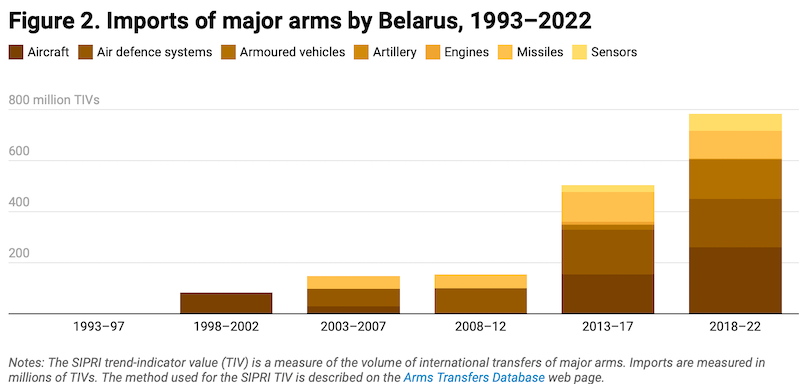
As figure 2 shows, the increase in five-year moving averages in import volumes over the past 10 years is roughly in line with the increase in Belarus’s military spending data over the same period.
In 2022 Belarus took delivery of an estimated 25 Iskander missiles along with four launchers; six Tor air defence systems; and one S-400 air defence system. The most important weapons currently on order from Russia are another eight Su-30 combat aircraft. When first imported, it was understood that all of these weapons were for use by Belarusian forces with conventional warheads, missiles or bombs. However, in March 2023, Russia announced it would base some of its nuclear warheads—under Russian control—in a non-strategic nuclear weapon storage facility in Belarus for later use with Belarusian Iskander missiles and as yet unidentified Belarusian combat aircraft.
Belarus was in fact a net arms exporter between 1993 and 2022. This was due to exports of second-hand weapons, mainly aircraft and armoured vehicles, as the country was reducing its cold war-era inventory to meet its obligations under the 1990 Treaty on Conventional Armed Forces in Europe.
Poland
The pattern of arms imports by Poland—which was among the first post-cold war intake of new NATO members—was very different from Belarus in the same period (see figure 3).
Poland’s imports, which overwhelmingly came from NATO allies, increased dramatically in the decade following its NATO accession in 1999.
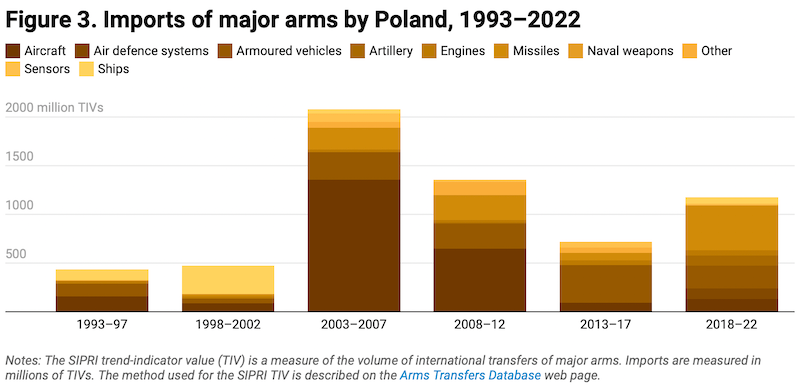
In the past few years, Poland has further diversified its arms imports and suppliers. Poland’s total arms import volume in the period was nearly three times that of Belarus, and these imports came on top of procurements from Poland’s significant domestic arms industry.
Latvia and Lithuania
Latvia and Lithuania have been net importers of arms since their independence, exporting only small quantities of second-hand or refurbished goods, much of it as aid to Ukraine in 2022. Both Latvia and Lithuania joined NATO in 2004.
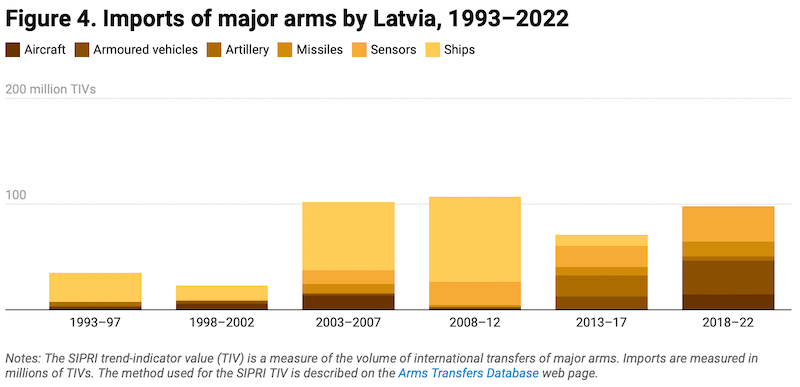
Both Latvia and Lithuania imported smaller volumes of major arms than Belarus during 1993–2022: the total TIV value of Latvia’s total imports was only 26 per cent that of Belarus’s, while Lithuania’s was 46 per cent. However, their acquisitions were more varied (see figures 4 and 5). Latvia’s imports were highest in 2003–12, particularly due to the acquisition of several ships; Lithuania’s imports remained relatively low until a sudden spike in 2018–22. Latvia is also expected to increase its arms imports in the coming years, along with its military spending.
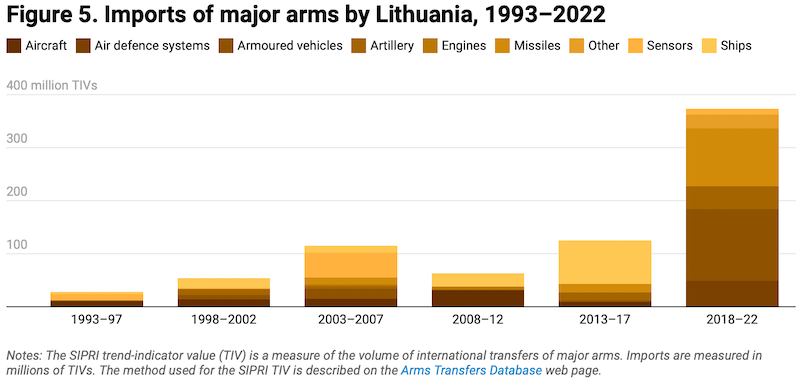
In trying to understand the import patterns (see figure 6) and assess the current military capabilities of any of these states, it is also necessary to take into account the military equipment they inherited from the Soviet period. Significant uncertainty remains about what military capabilities Belarus retained after independence. It may have been sufficient to meet the armed forces’ needs during the early and mid 1990s, and the increase in imports after 1998 was to fill gaps while Belarus developed the domestic capabilities to modernize older equipment.
Any more modern capabilities that Belarus possesses are assumed to be its more limited recent imports, which so far have largely been air defence systems and a few aircraft.

Alliances and other factors
While Latvia, Lithuania and Poland have become NATO members, Belarus has maintained close relations with Russia, forming the Union State of Russia and Belarus in the late 1990s. Although the Union State is primarily about establishing a common economic space, the two countries also have strongsecurity ties, including Russia’s extension of its nuclear umbrella to include Belarus from 2000. Naturally, these security guarantees influence the planning and allocation of funds for each state with regard to military affairs.
Wary of potential aggression from Russia, Poland considers itself to be on the frontlines of Europe’s defence. Thus, along with maintaining and developing its well-established domestic arms industry, Poland has supplemented perceived capability gaps by importing technologies. Latvia and Lithuania have relied on NATO for their security and planned their security requirements and military capability development accordingly.
Article 5 of the NATO Charter provides for the collective defence of all members. Thus, any attack on Latvia, Lithuania or Poland would potentially meet a response backed up by NATO allies. While the national armed forces of Latvia and Lithuania are much smaller than those of Belarus, there is a sizeable deployment of NATO forces in both countries. Poland has a significant military footprint, both in terms of its own military personnel and of its modern equipment, along with a NATO presence on its territory.
Of course, even without taking military alliances into account, a state’s capacity to undertake military operations is not determined by equipment and troop numbers alone. Other factors such as their training, logistical capacity, readiness of the equipment and morale of forces can all play a role.
Based on the information available in the public domain, Belarus’s capacity to engage in unilateral aggression against a NATO member state seems low. However, cross-border relations have been poor for some time, not least due to actions by Belarus apparently aimed at destabilizing its neighbours, such as orchestrating a surge of migrants into Lithuania in the summer of 2021.
Given the heated rhetoric, concerns about the Wagner Group troops recently stationed in Belarus, and armed forces put on high alert on both sides of the border, there is a real risk of dangerous escalation. It is imperative that all parties take a step back and assess how incidents can be handled, tensions eased and a larger confrontation avoided.
 Eurasia Press & News
Eurasia Press & News
